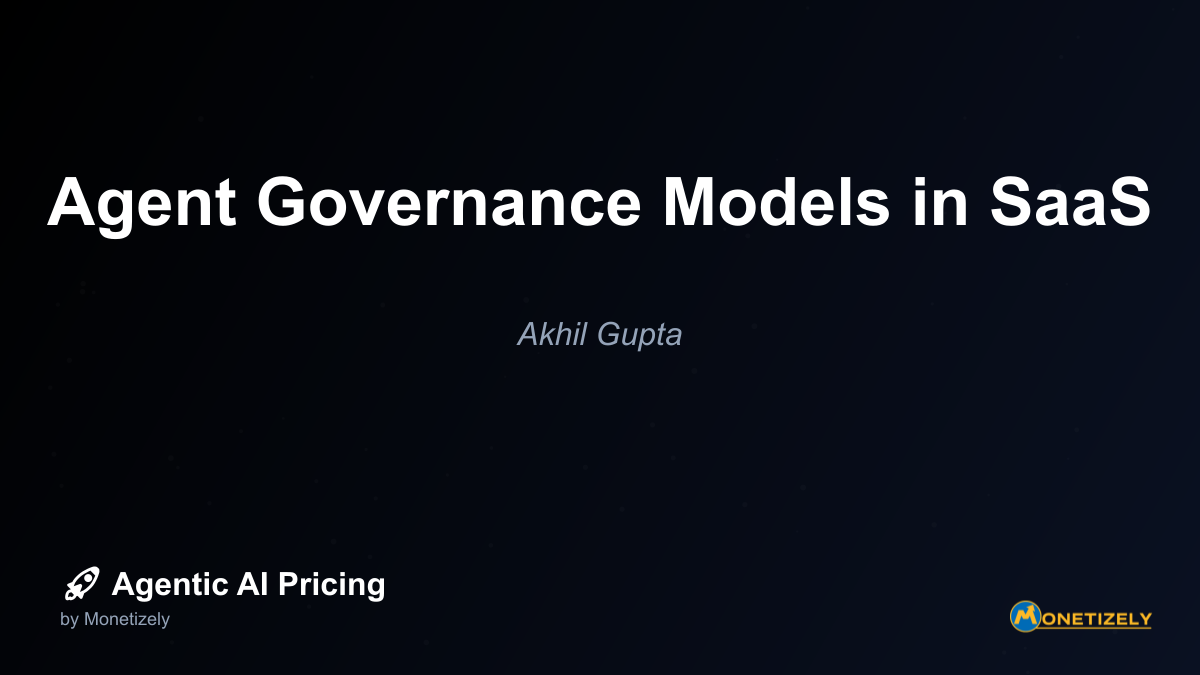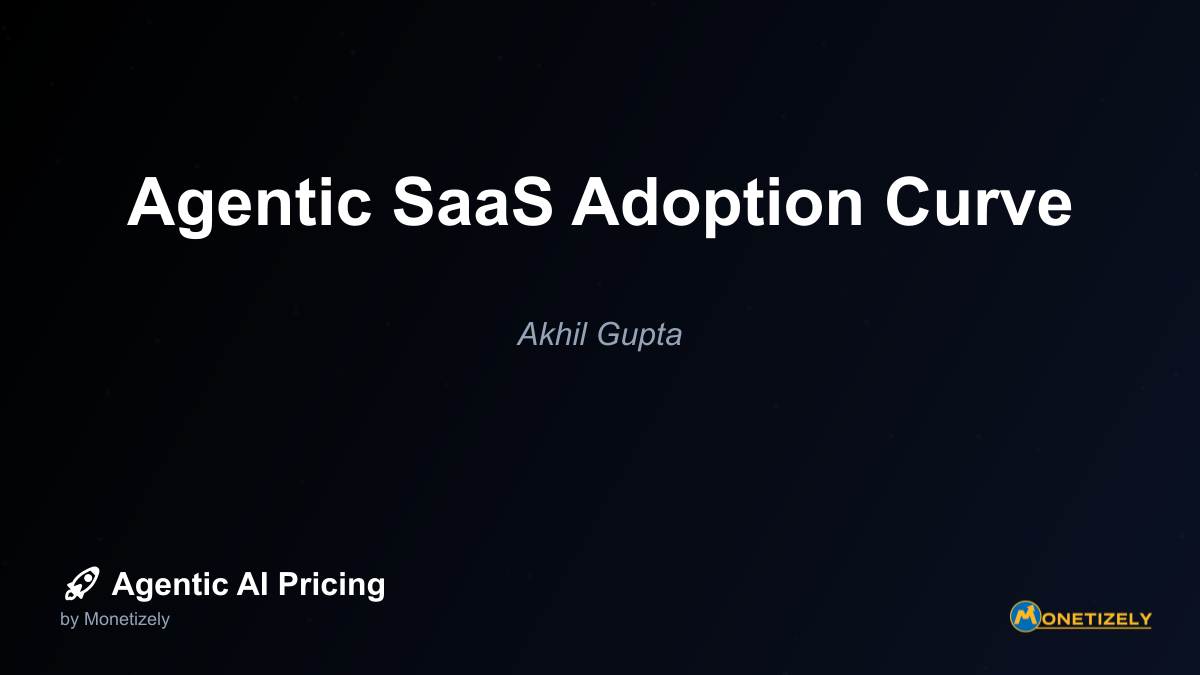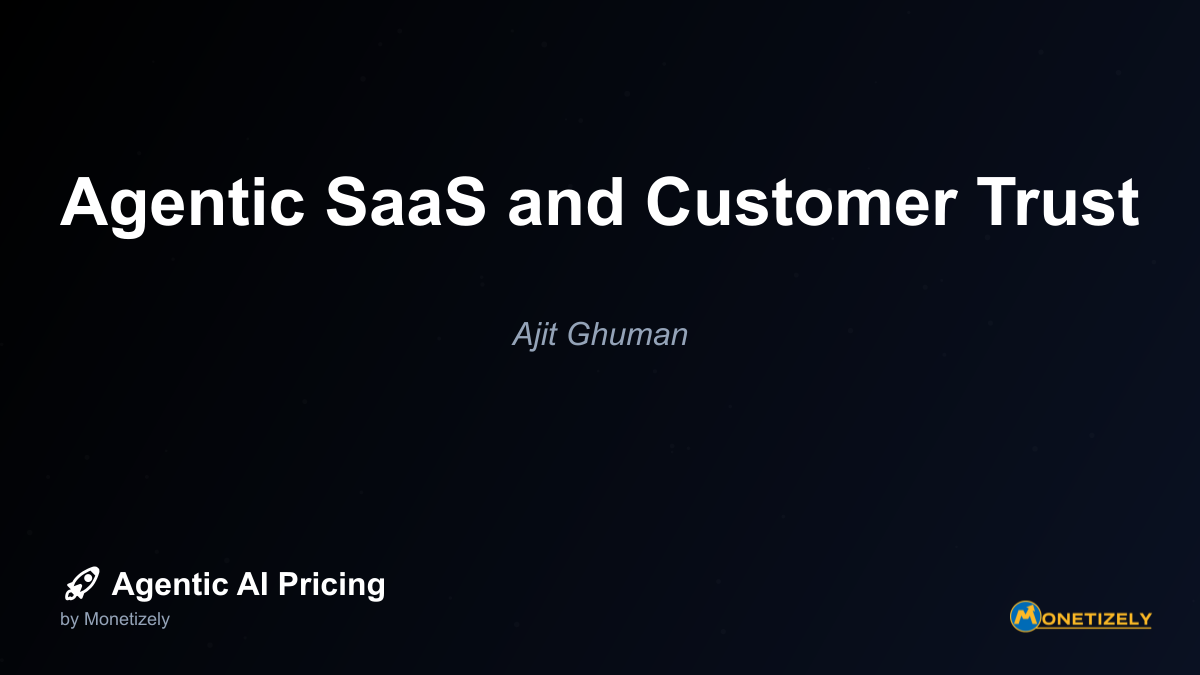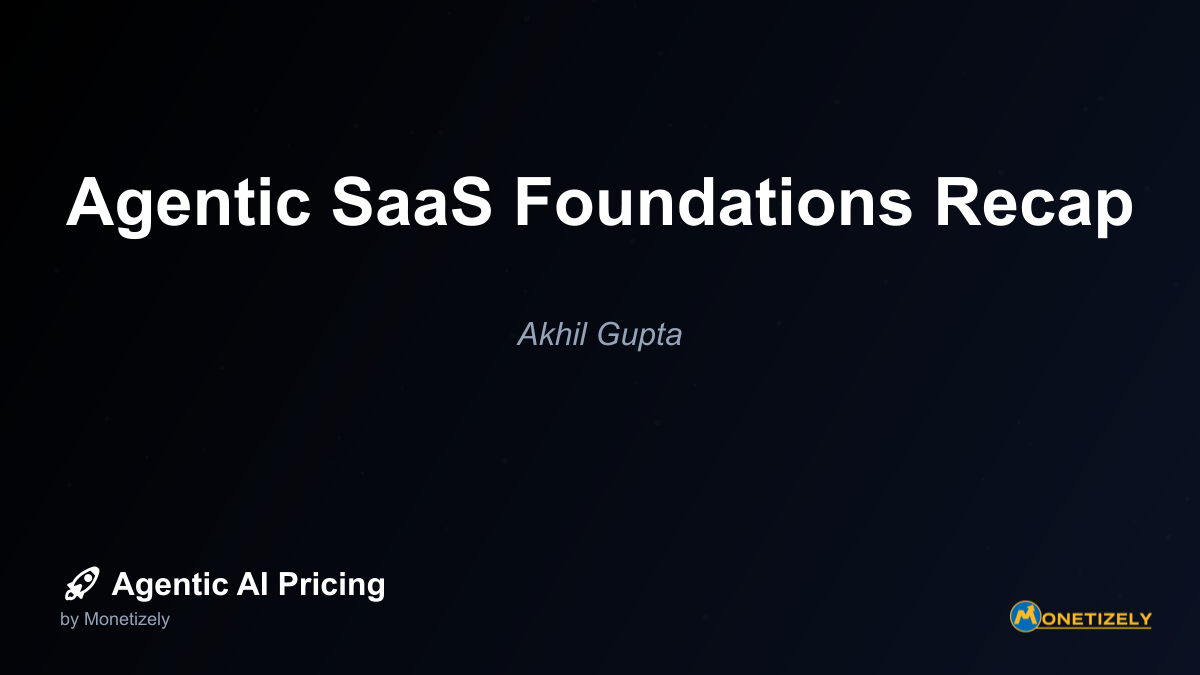· Ajit Ghuman · Agentic SaaS Fundamentals · 11 min read
Future-Proofing SaaS with Agentic Models
AI and SaaS Pricing Masterclass
Learn the art of strategic pricing directly from industry experts. Our comprehensive course provides frameworks and methodologies for optimizing your pricing strategy in the evolving AI landscape. Earn a professional certification that can be imported directly to your LinkedIn profile.

The SaaS industry stands at a pivotal crossroads as agentic AI models rapidly transform the landscape. Traditional software-as-a-service businesses now face both unprecedented opportunities and existential challenges in this new paradigm. The emergence of autonomous AI systems capable of independent decision-making and task execution is reshaping customer expectations, business models, and competitive dynamics.
For SaaS executives and product leaders, the transition to agentic models isn’t merely a feature enhancement—it represents a fundamental reimagining of how software delivers value. Companies that navigate this shift strategically will thrive, while those that cling to outdated paradigms risk obsolescence.
This comprehensive guide examines how SaaS businesses can future-proof their operations through a thoughtful, strategic transition to agentic AI models. We’ll explore implementation frameworks, pricing strategies, security considerations, and real-world case studies to provide actionable insights for organizations at any stage of this journey.
The Agentic AI Revolution in SaaS: Understanding the Paradigm Shift
The transition to agentic AI represents a profound evolution in how software delivers value. Unlike traditional SaaS applications that require significant human operation, agentic AI systems can autonomously set goals, make decisions, and execute actions with minimal supervision.
According to recent research from AlixPartners, 56% of SaaS vendors launched or tested embedded AI features in 2024, with 41% already monetizing them—a 9% increase from 2023. This rapid adoption reflects the competitive pressure to embrace autonomous capabilities before being left behind.
The shift goes beyond simply adding AI features. As McKinsey notes in their 2025 report on agentic AI adoption, “Organizations must move from fragmented, tactical AI experiments to strategic, organization-wide AI programs aligned with core business priorities.” This means reimagining entire workflows and decision architectures rather than merely enhancing existing processes.
For SaaS companies, this transition manifests in several key ways:
Conversion from dashboards to conversational interfaces: Traditional UI-driven interactions are being replaced by natural language interfaces and zero-friction agent workflows.
Collapsing of siloed applications: Business applications are evolving from isolated SaaS tools into AI-driven ecosystems that orchestrate processes across domains.
Shift from task automation to outcome automation: Rather than automating discrete steps, agentic systems focus on delivering complete business outcomes autonomously.
Evolution of pricing models: Traditional seat-based or subscription models are giving way to outcome-based and usage-based approaches that align with AI’s value delivery.
As CMSWire observed in early 2025, “The question isn’t whether agentic AI will transform SaaS, but how quickly and thoroughly the transformation will occur.”
Strategic Assessment: Is Your SaaS Business Ready for Agentic AI?
Before embarking on an agentic AI transition, SaaS leaders must conduct a comprehensive readiness assessment. This evaluation should examine multiple dimensions of organizational preparedness:
Technical Infrastructure Readiness
Cloud-native architecture: Agentic AI requires flexible, scalable infrastructure. Legacy monolithic applications may need significant refactoring.
API ecosystem maturity: Agents thrive in environments with robust, well-documented APIs that enable seamless integration and data exchange.
Data infrastructure: Assess data quality, accessibility, and governance frameworks that will support AI agent operations.
Business Model Compatibility
Value proposition alignment: Determine how agentic capabilities enhance your core value proposition rather than diluting it.
Customer readiness: Evaluate whether your customer base is prepared to adopt and extract value from autonomous features.
Competitive positioning: Map the competitive landscape to identify opportunities for differentiation through agentic capabilities.
Organizational Capabilities
AI talent and expertise: Assess your team’s capabilities in machine learning, natural language processing, and agent design.
Change management readiness: Evaluate your organization’s ability to manage the significant operational changes that agentic AI will require.
Leadership vision: Ensure executive alignment on the strategic importance and direction of agentic transformation.
A thorough readiness assessment provides the foundation for developing a tailored transition strategy. As SG Analytics noted in their 2025 analysis, “Organizations that succeed in agentic AI adoption begin with honest assessment of their technical and organizational readiness, allowing them to identify and address gaps before embarking on transformation initiatives.”
Building a Phased Transition Roadmap
Successful transitions to agentic AI typically follow a phased approach that balances innovation with operational stability. Based on case studies from companies that have navigated this journey effectively, a four-stage framework emerges:
Phase 1: Foundation Building (3-6 months)
Infrastructure modernization: Upgrade cloud infrastructure, APIs, and data systems to support agent operations.
Pilot use case identification: Select 2-3 high-impact, low-risk processes for initial agent implementation.
Team capability development: Invest in AI literacy and specific technical training for key team members.
Phase 2: Controlled Implementation (6-9 months)
Agent development and testing: Build and refine agents for pilot use cases in controlled environments.
Integration with existing systems: Establish secure connections between agents and core business systems.
Governance framework establishment: Develop monitoring, control, and accountability systems for agent operations.
Phase 3: Scaled Deployment (9-12 months)
Expansion to additional use cases: Apply learnings from pilots to implement agents across more business processes.
Customer onboarding: Develop strategies to help customers adopt and extract value from agentic capabilities.
Performance optimization: Refine agent performance based on operational data and feedback.
Phase 4: Business Model Evolution (12+ months)
Pricing model transformation: Shift toward value-based or outcome-based pricing that aligns with agent-delivered value.
Product roadmap realignment: Reorient product development to prioritize agentic capabilities and integrations.
Organizational restructuring: Adapt team structures and roles to support the new operating model.
This phased approach allows organizations to manage risk while systematically transforming their operations. As McKinsey emphasizes in their 2025 agentic AI research, “Organizations should focus transformation around end-to-end business processes, not isolated tasks, reimagining workflows and decision logic with agents orchestrating a major share of process execution.”
Technical Architectures for Agentic SaaS
The technical foundation for agentic AI implementation varies based on organizational needs, existing infrastructure, and strategic objectives. Three predominant architectural patterns have emerged in the market:
1. Super Platform Integration
This approach leverages existing AI platforms like Microsoft Copilot, Salesforce Agentforce, or similar enterprise systems that provide integrated agent capabilities.
Advantages:
- Faster time-to-market
- Reduced development complexity
- Enterprise-grade security and compliance
Limitations:
- Less customization flexibility
- Potential vendor lock-in
- May not address unique business requirements
Example Implementation: ServiceNow expanded its AI capabilities by acquiring Moveworks and integrating AI assistants across HR, IT, and finance to automate enterprise workflows, as documented in recent case studies.
2. AI Wrapper Architecture
This model places an intelligent interface layer between existing systems and users, adding agent capabilities without requiring fundamental system changes.
Advantages:
- Preserves investment in legacy systems
- Incremental implementation approach
- Lower initial disruption
Limitations:
- May perpetuate underlying system limitations
- Potential performance constraints
- Integration complexity
Example Implementation: United Wholesale Mortgage leveraged Google Cloud’s Vertex AI to build an AI agent layer that assists mortgage underwriters, doubling productivity without replacing core systems.
3. Custom Agent Development
This approach involves building purpose-designed agents tailored to specific business processes and integrated with proprietary systems.
Advantages:
- Maximum customization and differentiation
- Potential for unique competitive advantage
- Optimized for specific use cases
Limitations:
- Higher development complexity and cost
- Longer implementation timeline
- Greater internal expertise required
Example Implementation: TechCorp and MUFG developed custom AI agents for lead scoring and nurturing, resulting in a 3x increase in pipeline size and 25% improvement in conversion rates.
For most SaaS companies, a hybrid approach combining elements of these patterns proves most effective. As SketchDev’s 2025 implementation guide notes, “Successful agentic AI architectures typically blend off-the-shelf AI agents for routine tasks with custom-designed agents for strategic, high-value processes to maximize flexibility and competitive advantage.”
Security and Compliance Considerations
The autonomous nature of agentic AI introduces unique security and compliance challenges that SaaS providers must address proactively. Recent research from cybersecurity firms highlights several critical areas of focus:
Data Privacy and Protection
Agentic AI systems often access, modify, and share data across connected platforms, creating potential privacy risks. According to NudgeSecurity’s 2025 report, “The autonomous operation of AI agents creates risks of inadvertent data leakage or processing data in environments not covered by the same privacy frameworks.”
Key Mitigation Strategies:
- Implement comprehensive data classification and access controls
- Establish clear data handling policies for agent operations
- Deploy real-time monitoring for unusual data access patterns
- Conduct regular privacy impact assessments for agent workflows
Regulatory Compliance Across Jurisdictions
SaaS providers must ensure agentic AI respects regional data protection regulations such as GDPR (EU), CCPA (California), and industry-specific requirements like HIPAA.
Key Mitigation Strategies:
- Map agent workflows against regulatory requirements by region
- Implement geofencing for data processing when necessary
- Maintain comprehensive audit trails of agent actions
- Develop region-specific compliance documentation
Authentication and Access Control
The persistent use of OAuth tokens, API keys, and other credentials by agentic AI increases exposure to privileged access misuse or theft.
Key Mitigation Strategies:
- Implement least privilege principles for all agent credentials
- Establish automated credential rotation and monitoring
- Deploy anomaly detection for agent authentication patterns
- Create segregation of duties between agent functions
Multi-Agent Risk Management
As organizations deploy multiple agents across different domains, new risks emerge from agent interactions and potential cascading failures.
Key Mitigation Strategies:
- Develop clear boundaries and interaction protocols between agents
- Implement circuit-breaker patterns to prevent cascading issues
- Create centralized monitoring of cross-agent activities
- Establish hierarchical governance structures for agent oversight
CyberArk’s 2025 analysis emphasizes that “SaaS providers adopting agentic AI models must upgrade governance, monitoring, and incident response capabilities to maintain control over autonomous AI actions.” This requires treating AI agents similar to employees in terms of onboarding, access reviews, and governance policies.
Reimagining Pricing and Monetization Models
The transition to agentic AI necessitates a fundamental reconsideration of how SaaS products are priced and monetized. Traditional models often fail to capture the unique value dynamics of autonomous systems.
Value-Based Pricing Approaches
Agentic AI delivers value through autonomous task completion and measurable business outcomes rather than just providing access to features. According to Monetizely’s 2025 AI pricing research, this shift demands pricing models that “link directly to the value AI creates, not merely consumption or seats.”
Emerging Models:
- Outcome-based pricing: Charging based on successful business outcomes (e.g., loans processed, tickets resolved)
- Productivity-based pricing: Fees tied to measurable productivity improvements
- Value-share models: Revenue sharing based on quantifiable value delivered
Subscription vs. Usage-Based Models
The industry is witnessing a shift from pure subscription models toward hybrid approaches that better align with AI’s variable cost and value structure.
| Model | Description | Best For | Pros | Cons |
|---|---|---|---|---|
| Subscription (Per seat or agent) | Fixed recurring fee, often per user or AI agent seat | Predictable revenue, core platform access | Predictable revenue; easy budgeting | Not always aligned with AI-induced cost & value variability |
| Usage-Based | Charge per unit of AI activity (calls, tasks, compute) | Variable AI usage, pay-for-performance | Fairer to customer; aligns costs to consumption | Revenue less predictable; pricing complexity risk |
| Outcome-Based | Charge per successful business result (e.g., per resolution) | High-value agent outcomes with clear KPIs | Best aligns pricing with delivered value; incentivizes performance | Requires reliable outcome measurement; risk in outcome variability |
Recent industry benchmarks provide guidance on specific pricing metrics:
| Company | Pricing Metric | Price Example (2025) |
|---|---|---|
| Salesforce | Per conversation | $2 per conversation |
| Microsoft Azure AI | Per compute hour | $4 per hour |
| Intercom | Per resolution (outcome-based) | $0.99 per resolution |
| Devin’s Cognition AI | Per AI compute unit | $2.25 per unit |
| Kittl | Per image generation credit | 20 credits/image |
Pricing Challenges and Pitfalls
SaaS companies transitioning to agentic models should be aware of common pricing pitfalls:
Blindly applying traditional SaaS pricing to agentic AI leads to poor value capture and misalignment with AI’s cost structure.
Overcomplicating pricing with too many metrics or tiers creates confusion for sales teams and customers.
Ignoring AI’s compute and data costs can lead to underpricing and unsustainable economics.
Failing to capture customer outcome data undermines the effectiveness of value-based models.
As TechCircle noted in August 2025, “The transition to agentic AI demands pricing innovation that balances simplicity for customers with accurate value capture for providers.”
Case Studies: Successful Agentic AI Transitions
Examining real-world examples provides valuable insights into effective transition strategies. The following case studies highlight diverse approaches across different industries:
TechCorp & MUFG: Transforming Outbound Sales
Industry: SaaS Marketing / Financial Services
Implementation Approach:
- Adopted agentic AI platforms to automate lead scoring, qualification, and outreach
- Integrated with existing CRM systems to streamline pipeline management
- Implemented AI-driven conversation analytics to refine messaging
Challenges:
- Manual lead qualification was resource-intensive and inefficient
- Need to personalize outreach at scale without overwhelming sales teams
Solutions:
- AI-powered lead scoring that prioritized high-potential leads
- Automated, personalized outreach campaigns operated by AI agents
- Conversation analytics to refine messaging and engagement
Outcomes:
- 3x increase in pipeline size (300% growth in qualified leads)
- 25% improvement in conversion rates
- More efficient allocation of sales team resources
United Wholesale Mortgage: Automating Underwriting
Industry: Mortgage / Financial Services
Implementation Approach:
- Leveraged Google Cloud’s Vertex AI and Gemini models for underwriter assistance
- Automated document analysis and decision support workflows
- Maintained human oversight for final approvals
Challenges:
- Traditional underwriting was time-consuming, causing delays
- Need to maintain accuracy while accelerating processes
Solutions:
- AI agents that preprocess application data and suggest next steps
- Automated documentation generation and validation
- Integration with existing loan processing systems
Outcomes:
- Over 2x increase in underwriter productivity within 9 months
- Shorter loan close times benefiting more than 50,000 brokers
- Improved accuracy in application processing
Elisa: Revolutionizing Telecom Customer Support
Industry: Telecommunications
Implementation Approach:
- Developed “Annika,” an AI-powered chatbot for customer inquiries
- Implemented continuous learning from customer interactions
- Integrated with backend systems for seamless issue resolution
Challenges:
- Managing high volumes (560,000 clients) of support tickets
- Providing consistent, rapid responses to diverse inquiries
Solutions:
- 24/7 autonomous operation with learning capabilities
- Natural language understanding for complex customer intent
- Seamless escalation to human agents when necessary
Outcomes:
- Significant reduction in human intervention for routine inquiries
- Improved customer satisfaction through faster resolution
- Cost savings through automation of repetitive tasks
These case studies reveal common success factors across different implementations:
- Integration with existing systems is critical for maximizing value
- Automating multi-step workflows yields greater benefits than isolated tasks
- Continuous learning mechanisms enhance agent performance over time
- Clear metrics for success guide implementation and optimization efforts
Workforce Implications and Change Management
The transition to agentic AI significantly impacts organizational structure, roles, and required skills. Managing this change effectively is crucial for successful implementation.
Evolving Roles and Responsibilities
As agentic AI assumes routine tasks, human roles shift toward higher-value activities:
- From execution to oversight: Employees transition from performing tasks to monitoring and guiding AI agents
- From routine to exception handling: Human expertise focuses on complex edge cases and unusual scenarios
- From tactical to strategic: Staff can dedicate more time to innovation and strategic initiatives
Skill Development Priorities
Organizations must invest in developing new capabilities among their workforce:
- AI literacy: Basic understanding of AI capabilities, limitations, and appropriate use cases
- Agent management: Skills for configuring, monitoring, and optimizing AI agent performance
- Complex problem solving: Enhanced ability to address non-
Co-Founder & CEO
Ajit is the author of Price To Scale, a top book on SaaS Pricing and is the Founder of Monetizely. Ajit has led and worked in pricing and product marketing at firms like Twilio, Narvar and Medallia. His work has been featured in Forbes and VentureBeat. Ajit regularly consults with software companies from Seed stage to post-IPO on pricing strategy. Ajit is also a highly-rated co-instructor for 'The Art of SaaS Pricing and Monetization' on Maven.
Pricing Strategy Audit
Let our experts analyze your current pricing strategy and identify opportunities for improvement. Our data-driven assessment will help you unlock untapped revenue potential and optimize your AI pricing approach.




